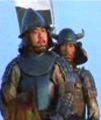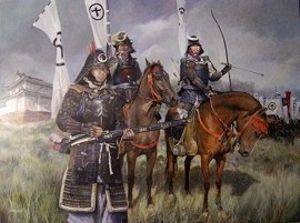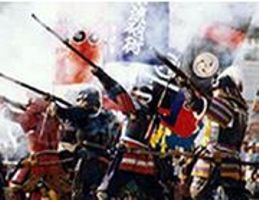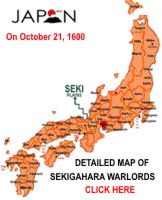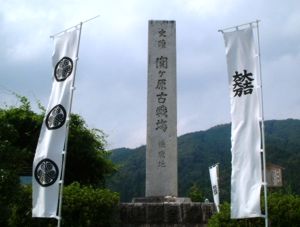 |
THE
TOKUGAWA CLAN'S DECISIVE BATTLE OF |
When the Lord Chancellor Toyotomi Hideyoshi died in 1598, he left his baby boy, the would-be Chief Minister Toyotomi Hideyori, to 5 most powerful men in Japan of the time. If it was just a kid there wouldn't have been anything going on, but this kid was the one and only son of a man who controlled most of Japan in late 1500's. So naturally the warring instinct got tickled heavily. The five men, hitherto called 'Regents', were Tokugawa Ieyasu, Ukita Hideie, Maeda Toshiie, Uesugi Kagekatsu, and Mori Terumoto. Except Lord Maeda, who was Toyotomi Hideyoshi's best buddy since both of them were just under 18, all others were former enemies or defeated warlords. Among them, actually Tokugawa Ieyasu was not the strongest, if we compare the resources he could tap; but he was the best mind when it came to strategizing. And he was the most ambitious, too. This was crucial. The battle broke in October 21, 1600 at the Seki plain in today's Gifu Prefecture (click here for pictures). Too much has been said about it everywhere, so the thing you should remember is only that Tokugawa, of course, won the war. The former Toyotomi men, led by Lord Ishida Mitsunari, was 90,000 people strong -- but they couldn't even stir the 60,000 Tokugawa soldiers up. It remains a sort of mystery why Ishida came to be the Chief of this joint staff. He was no real fighter, and no one ever heard him proposing any workable strategy to their General Toyotomi when he was still around. Toyotomi himself would have gotten really sad to see that his heir's future was decided by this man. But his buddy Maeda Toshiie had died just barely a year after himself; none of the living 4 Regents was trustworthy as far as the Toyotomis were concerned. |
|
|
|
||
|
Tokugawa
Ieyasu (front)
|
Lord Maeda Toshiie in old age. He was lucky not to witness the massacre of the comrades he knew. Click the pic for story and pictures.
|
The
Chief of the so-called
|
Lord Uesugi Kagekatsu (1556-1623), adopted son of the legendary warlord of Echigo Uesugi Kenshin (his clan was actually Ueda), was involved in the overall battling sessions for his own ends.
|
|
|
 |
 |
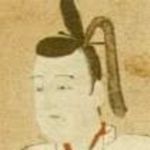 |
| Lord Ukita Hideie (1573-1655) came from the all-famous clan of warriors of Bizen (today's Okayama). | Lord Mori Terumoto (1553-1624) wasn't a passably good General. Of that everyone in his times agreed. | Lord Kobayakawa Hideaki (1582-1602) turned the tide of the war by inaction, and after that plunged it to irrepairable damage by defection. | Chief Minister Toyotomi Hideyori didn't have what his father Hideyoshi got to turn losses into victories. Click him for story and pictures. |
Then again, Ishida might have written a different history, if not for one thing -- his ally, the young Lord Kobayakawa Hideaki, did come to the battlefield with his army, but that was about all. Kobayakawa (the name means 'small swift stream') somehow thought that he shouldn't get involved in this war. Seeing that he just sat on his horse without apparent signals of getting prepared to fight, Tokugawa Ieyasu ordered his snipers to shoot at the Kobayakawa Generals. After that, Kobayakawa rode into the war -- on Tokugawa's side. Kobayakawa Hideaki was the son of Kinoshita Iesada, and -- as his original clan's name shows, since it was Hideyoshi's previous surname too -- actually he was a nephew of Toyotomi Hideyoshi, hence Hideyori's own cousin. He was even adopted once into the family of Toyotomi, before getting himself re-adopted by the Kobayakawa clan via Kobayakawa Takakage. |
|
The Tokugawa camp at Sekigahara, attended by Honda Heihachi, (1548-1618, he was also called 'Tadakatsu') Lord of Kuwana, the best of the Tokugawa Generals.
|
In this 'Tokugawa versus Everybody Else' war, everything was used: guns, cannons, archery kits, swords, bare hands, rocks.....
|
|||||||
|
The gunners in action
|
Click the picture
above for detailed map of Japan on October 21, 1600
|
|||||||
|
The
monument at Sekigahara in 2005,
|
|||||||
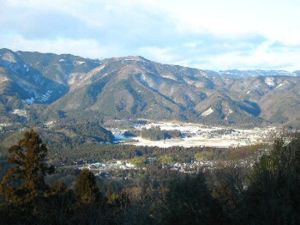 |
 |
In the aftermath, Lord Mori Terumoto who battled from his own territory survived, and even still got hold of Nagato and Suo by Tokugawa's permission. This might have been a deserved pardon. Mori, the builder of today's Hiroshima castle, was able to mobilize no less than 120,000 men to back Ishida Mitsunari up at Sekigahara; but he didn't do that. Ishida Mitsunari and others who survived the battle took refuge at the Sawayama castle. They were taken out from there by the Tokugawa army. Ishida was beheaded at the Gamo riverbanks, near Tokyo today, according to tradition 'by a very blunt sword' specially selected for the occasion, as additional sadism to Tokugawa Ieyasu's treatment of him. Tokugawa Ieyasu wasn't considered too brutal in his days -- so this was uncharacteristic of him. Also executed was Toyotomi Hideyoshi's Christian (Catholic) General, Lord Konishi Yukinaga (click here for story and pictures of his glory days with Toyotomi). The Tokugawa shogunate in general never welcomed Christianity at all, unlike Toyotomi Hideyoshi's tolerance and Oda Nobunaga's open hands. Tokugawa Ieyasu wasn't so hard on the Japanese Catholics at first, but by the time of his grandson Iemitsu being a Christian in Japan meant death. (Click here for Tokugawa Iemitsu's story and pictures). However, in this aftermath of Sekigahara, Tokugawa Ieyasu showed his respect toward Konishi Yukinaga by offering him a samurai death -- 'seppuku'. Only Konishi refused to do it, saying that his religion condemns all kinds of suicide. So he died like a criminal or war losers, like Ishida, by executioners. A part of historians consider this as Tokugawa's sick sense of humor (because no way he didn't know about the Christian abhorrence of suicide). But I tend to agree with another clot of historians who think it was a genuine acknowledgement of Konishi's samurainess despite the lack of pedigree. Tokugawa Ieyasu let Konishi's son to stand aside during the battle because he didn't want to fight against his dad (the son was on Tokugawa's side, by his own choice), and didn't reprimand or 'fine' him for it afterwards, and let him stay in service. That means something about Tokugawa's real thought of Konishi Yukinaga.
Others were not that unfortunate. Another of Toyotomi's most famous Generals, Kato Kiyomasa, survived; he acknowledged the authority of the Tokugawa shogunate. |
